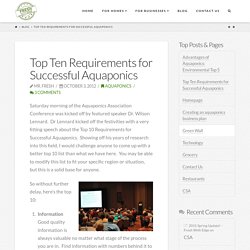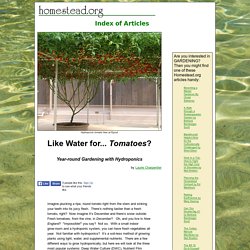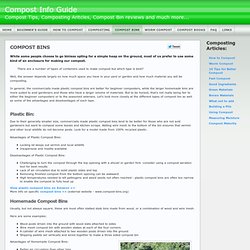

Top 10 Requirements for successful aquaponics. Saturday morning of the Aquaponics Association Conference was kicked off by featured speaker Dr.

Wilson Lennard. Dr Lennard kicked off the festivities with a very fitting speech about the Top 10 Requirements for Successful Aquaponics. Showing off his years of research into this field, I would challenge anyone to come up with a better top 10 list than what we have here. You may be able to modify this list to fit your specific region or situation, but this is a solid base for anyone. So without further delay, here’s the top 10: Information Good quality information is always valuable no matter what stage of the process you are in. These are the top 10 requirements for successful aquaponics that Dr Lennard listed out for everyone.
Practical Aquaponics Discussion Forum. A place to discuss every aspect of Aquaponics. Aquaponics – the Automated Ubergarden of the Future. An Introduction from MMM: I was late to the party in learning about aquaponics, but it made a big impression on me when I toured a massively creative food facility two years ago.

The slightly wild entrepreneurial founder had converted some cheap, remote industrial buildings in Loveland, Colorado into a spectacularly productive indoor farm. Expensive herbs, heirloom tomatoes and fluffy fish were popping out at high speed, with (mostly solar) energy and sparse human labor as the only inputs. With over 40% of the Earth’s land area already converted to farms, I was excited by the idea that someday we may be able to get much more food out of much less land with a lower input of oil and chemicals. This kicked off a bit of an aquaponics reading binge on my part. So we collaborated over the past four months to create something worthy of sharing with you.
High-Tech Gardening and the Kick-Ass ROIby Jeremiah Robinson Can you guess what it is? I’ll give you a hint. Rediscovered The Math Objections. Wild tomatoes (plants forum at permies) "Like Water for... Tomatoes?" by Laurie Charpentier page one. Imagine plucking a ripe, round tomato right from the stem and sinking your teeth into its juicy flesh.

There’s nothing tastier than a fresh tomato, right? Now imagine it’s December and there’s snow outside. Fresh tomatoes, from the vine, in December? Oh, and you live in New England? "Impossible! " Image credit steadygrowpro.com One disadvantage to this grow method is that your plants must all require the same amount of watering and nutrient type and strength.
Making a Compost Pile: Essential articles and commentary on compost and the composting process. Making a compost pile is like making a giant layer cake!

Well, not exactly but you will soon see what we mean. But first, a few words about the amount of brown (carbon) material, versus green (nitrogen) material to put into your compost bin. Adding too much brown material will result in a pile that takes a long time to break down wheras too much green material will result in a slimy, smelly pile that doesn't heat up effectively. In order for our pile to break down quickly and efficiently we need to provide just the right balance of brown and green materials.
The microorganisms in our compost bins need both carbon and nitrogen to thrive; carbon for energy and nitrogen for protein synthesis. Unfortunately, most composting materials don't have a carbon to nitrogen (C:N) ratio of 30:1. Here's an example: Compost Bins: Compost bin reviews, info on compost bins, tumblers and compost piles. While some people choose to go binless opting for a simple heap on the ground, most of us prefer to use some kind of an enclosure for making our compost.

There are a number of types of containers used to make compost but which type is best? Well, the answer depends largely on how much space you have in your yard or garden and how much material you will be composting. In general, the commercially made plastic compost bins are better for beginner composters, while the larger homemade bins are more suited to avid gardeners and those who have a larger volume of materials.
But to be honest, that's not really being fair to either the beginner composters or to the seasoned veterans. Let's look more closely at the different types of compost bin as well as some of the advantages and disadvantages of each type.